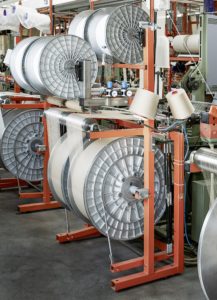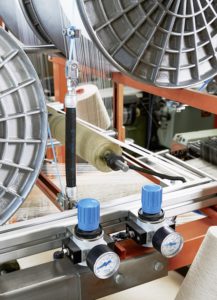Edited by Mike Santora
Wernli was the first textile manufacturer in the world to produce colored dressing materials. Now its cohesive and adhesive elastic bandages, as well as compression bandages, show it continues to be on the cutting edge. Innovations like bandages with sensors for measuring fever or for therapeutic pressure regulation – coupled with an app for intuitive operation – will enable the textile manufacturer to continue to compete.

In the past, lead weights weighing between 2.5 and 15 kg had to be hung on the warp beams of a loom. Now the job of the weights is done by a solution from Festo.
(Photo: Festo AG & Co. KG)
85% of the 10 million bandages it produces each year are exported. The goods are shipped to 27 countries, with Germany accounting for the largest share at present. The Wernli facility processed 336 tons of yarn in 2014. Laid end to end, the finished bandages would reach over 51,000 km or more than once around the Equator.
When the company looked to create its Bi-Flex type bandages, the challenge was making a product that was elastic both lengthways and crossways.
Constant yarn tension
To achieve this elasticity, the warp beams from which the yarn is continuously unwound must move under constant tension. As more yarn is unwound, the speed of the warp beams would increase and produce an unevenly elastic bandage fabric. Employees, therefore, had to hang lead weights weighing between 2.5 and 15 kg on the warp beams. The more the yarn was unwound, the more the weight on the warp beams had to be compensated. This was cumbersome, imprecise and prone to accidents because the weights sometimes moved and soiled the yarn or even ripped it midway through the weaving process. They turned to Festo for another solution.
“Our Festo technical consultant told me about the fluidic muscle DMSP,” says Ruedi Leutert, Head of Prework/Weaving and Yarn Purchasing at Wernli. Festo’s fluidic muscle eliminated the need for the weights and the yarn tension is set precisely using pressure regulators at the pressure gauge. The pneumatic drive has clear advantages for this application compared with a conventional pneumatic cylinder: since it does not have a piston rod, friction and therefore the stick-slip effect are not a problem. The movement is completely jerk-free. Together with the precise closed-loop control, the yarns are now optimally tensioned. This guarantees the high quality of the finished bandages.

With the fluidic muscle, there is no longer a need for weights and the yarn tension is set precisely using pressure regulators at the pressure gauge.
(Photo: Festo AG & Co. KG)
Sturdy and precise fluidic muscle
The force of the fluidic muscle is also many times greater than that of a cylinder of comparable size. As a hermetically sealed tube, the muscle is also insensitive to particles and dirt, which is important in the dusty environment of a textile factory. In addition to improving the quality of the products, the risk of accident is reduced: employees no longer have to worry about bumping into the weights as they walk past them or injuring themselves as they attach or remove them. A further advantage is that the fluidic muscle needs much less installation space compared with the weights.
Additionally, the fully automatic closed-loop control using the proportional valve VPPM and corresponding sensors could replace the manual adjustment of the muscle at the pressure gauge.
In fact, the proportional valve VPPM is a suitable closed-loop controller for different pneumatic applications, thanks to its ability to control the movements of the actuator with different speeds or forces. For each individual application, users can select the appropriate parameters from three presets (fast, universal and precise) at the touch of a button. An optional LCD indicates the pressure and offers diagnostic functions on site.
Festo
www.festo.com/textile
Filed Under: Pneumatic Tips